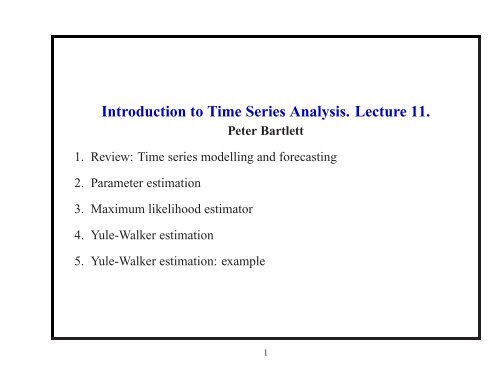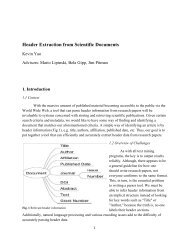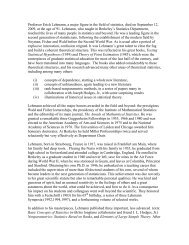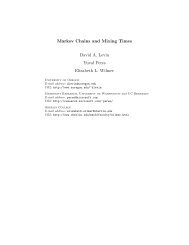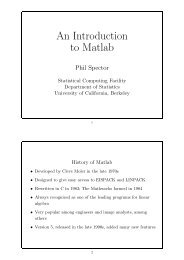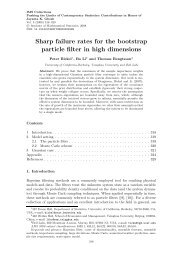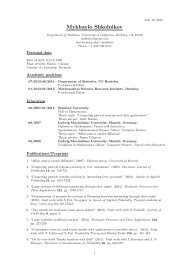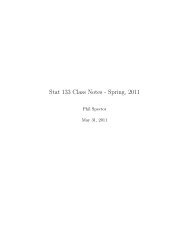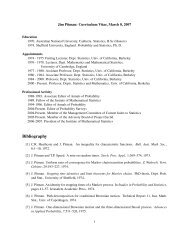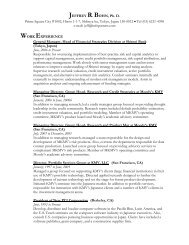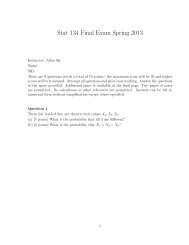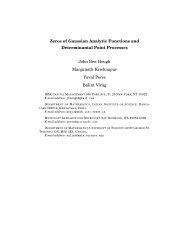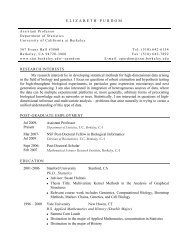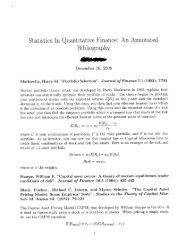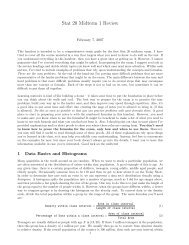Introduction to Time Series Analysis. Lecture 11. Peter Bartlett
Introduction to Time Series Analysis. Lecture 11. Peter Bartlett
Introduction to Time Series Analysis. Lecture 11. Peter Bartlett
You also want an ePaper? Increase the reach of your titles
YUMPU automatically turns print PDFs into web optimized ePapers that Google loves.
<strong>Introduction</strong> <strong>to</strong> <strong>Time</strong> <strong>Series</strong> <strong>Analysis</strong>. <strong>Lecture</strong> <strong>11.</strong><br />
<strong>Peter</strong> <strong>Bartlett</strong><br />
1. Review: <strong>Time</strong> series modelling and forecasting<br />
2. Parameter estimation<br />
3. Maximum likelihood estima<strong>to</strong>r<br />
4. Yule-Walker estimation<br />
5. Yule-Walker estimation: example<br />
1
Review (<strong>Lecture</strong> 1): <strong>Time</strong> series modelling and forecasting<br />
1. Plot the time series.<br />
Look for trends, seasonal components, step changes, outliers.<br />
2. Transform data so that residuals are stationary.<br />
(a) Remove trend and seasonal components.<br />
(b) Differencing.<br />
(c) Nonlinear transformations (log, √ ·).<br />
3. Fit model <strong>to</strong> residuals.<br />
4. Forecast time series by forecasting residuals and inverting any<br />
transformations.<br />
2
Review: <strong>Time</strong> series modelling and forecasting<br />
Stationary time series models: ARMA(p,q).<br />
•p = 0: MA(q),<br />
•q = 0: AR(p).<br />
We have seen that any causal, invertible linear process has:<br />
an MA(∞) representation (from causality), and<br />
an AR(∞) representation (from invertibility).<br />
Real data cannot be exactly modelled using a finite number of parameters.<br />
We choose p,q <strong>to</strong> give a simple but accurate model.<br />
3
Review: <strong>Time</strong> series modelling and forecasting<br />
How do we use data <strong>to</strong> decide on p,q?<br />
1. Use sample ACF/PACF <strong>to</strong> make preliminary choices of model order.<br />
2. Estimate parameters for each of these choices.<br />
3. Compare predictive accuracy/complexity of each (using, e.g., AIC).<br />
NB: We need <strong>to</strong> compute parameter estimates for several different model<br />
orders.<br />
Thus, recursive algorithms for parameter estimation are important.<br />
We’ll see that some of these are identical <strong>to</strong> the recursive algorithms for<br />
forecasting.<br />
4
Review: <strong>Time</strong> series modelling and forecasting<br />
Model: ACF: PACF:<br />
AR(p) decays zero forh > p<br />
MA(q) zero forh > q decays<br />
ARMA(p,q) decays decays<br />
5
<strong>Introduction</strong> <strong>to</strong> <strong>Time</strong> <strong>Series</strong> <strong>Analysis</strong>. <strong>Lecture</strong> <strong>11.</strong><br />
1. Review: <strong>Time</strong> series modelling and forecasting<br />
2. Parameter estimation<br />
3. Maximum likelihood estima<strong>to</strong>r<br />
4. Yule-Walker estimation<br />
5. Yule-Walker estimation: example<br />
6
Parameter estimation<br />
We want <strong>to</strong> estimate the parameters of an ARMA(p,q) model.<br />
We will assume (for now) that:<br />
1. The model order (p and q) is known, and<br />
2. The data has zero mean.<br />
If (2) is not a reasonable assumption, we can subtract the sample mean ¯y,<br />
fit a zero-mean ARMA model,<br />
φ(B)Xt = θ(B)Wt,<br />
<strong>to</strong> the mean-corrected time series Xt = Yt − ¯y,<br />
and then use Xt + ¯y as the model for Yt.<br />
7
Parameter estimation: Maximum likelihood estima<strong>to</strong>r<br />
One approach:<br />
Assume that {Xt} is Gaussian, that is,φ(B)Xt = θ(B)Wt, where Wt is<br />
i.i.d. Gaussian.<br />
Chooseφi,θj <strong>to</strong> maximize the likelihood:<br />
L(φ,θ,σ 2 ) = f φ,θ,σ 2(X1,...,Xn),<br />
where fφ,θ,σ2 is the joint (Gaussian) density for the given ARMA model.<br />
(c.f. choosing the parameters that maximize the probability of the data.)<br />
8
Maximum likelihood estimation<br />
Suppose that X1,X2,...,Xn is drawn from a zero mean Gaussian<br />
ARMA(p,q) process. The likelihood of parameters φ ∈ R p ,θ ∈ R q ,<br />
σ 2 w ∈ R+ is defined as the density of X = (X1,X2,...,Xn) ′ under the<br />
Gaussian model with those parameters:<br />
L(φ,θ,σ 2 w) =<br />
1<br />
(2π) n/2 exp<br />
1/2<br />
|Γn|<br />
�<br />
− 1<br />
2 X′ Γ −1<br />
�<br />
n X ,<br />
where |A| denotes the determinant of a matrix A, and Γn is the<br />
variance/covariance matrix of X with the given parameter values.<br />
The maximum likelihood estima<strong>to</strong>r (MLE) ofφ,θ,σ 2 w maximizes this<br />
quantity.<br />
9
Parameter estimation: Maximum likelihood estima<strong>to</strong>r<br />
Advantages of MLE:<br />
Efficient (low variance estimates).<br />
Often the Gaussian assumption is reasonable.<br />
Even if{Xt} is not Gaussian, the asymp<strong>to</strong>tic distribution of the estimates<br />
( ˆ φ, ˆ θ,ˆσ 2 ) is the same as the Gaussian case.<br />
Disadvantages of MLE:<br />
Difficult optimization problem.<br />
Need <strong>to</strong> choose a good starting point (often use other estima<strong>to</strong>rs for this).<br />
10
Preliminary parameter estimates<br />
Yule-Walker for AR(p): Regress Xt on<strong>to</strong>Xt−1,...,Xt−p.<br />
Durbin-Levinson algorithm withγ replaced by ˆγ.<br />
Yule-Walker for ARMA(p,q): Method of moments. Not efficient.<br />
Innovations algorithm for MA(q): withγ replaced by ˆγ.<br />
Hannan-Rissanen algorithm for ARMA(p,q):<br />
1. Estimate high-order AR.<br />
2. Use <strong>to</strong> estimate (unobserved) noiseWt.<br />
3. Regress Xt on<strong>to</strong>Xt−1,...,Xt−p, ˆ Wt−1,..., ˆ Wt−q.<br />
4. Regress again with improved estimates ofWt.<br />
11
Yule-Walker estimation<br />
For a causal AR(p) model φ(B)Xt = Wt, we have<br />
⎛ ⎛ ⎞⎞<br />
E<br />
p�<br />
⎝Xt − ⎠⎠<br />
= E(Xt−iWt) for i = 0,...,p<br />
⎝Xt−i<br />
j=1<br />
φjXt−j<br />
⇔ γ(0)−φ ′ γp = σ 2<br />
γp −Γpφ = 0,<br />
and<br />
where φ = (φ1,...,φp) ′ , and we’ve used the causal representation<br />
Xt = Wt +<br />
<strong>to</strong> calculate the values E(Xt−iWt).<br />
12<br />
∞�<br />
j=1<br />
ψjWt−j
Yule-Walker estimation<br />
Method of moments: We choose parameters for which the moments are<br />
equal <strong>to</strong> the empirical moments.<br />
In this case, we choose φ so that γ = ˆγ.<br />
Yule-Walker equations for ˆ φ:<br />
These are the forecasting equations.<br />
We can use the Durbin-Levinson algorithm.<br />
13<br />
⎧<br />
⎨ˆΓp<br />
ˆ φ = ˆγp,<br />
⎩<br />
ˆσ 2 = ˆγ(0)− ˆ φ ′ ˆγp.
Some facts about Yule-Walker estimation<br />
• If ˆγ(0) > 0, then ˆΓm is nonsingular.<br />
• In that case, ˆ φ = ˆ Γ −1<br />
p ˆγp defines the causal model<br />
Xt − ˆ φ1Xt−1 −···− ˆ φpXt−p = Wt, {Wt} ∼ WN(0,ˆσ 2 ).<br />
• If {Xt} is an AR(p) process,<br />
�<br />
ˆφ ∼ AN φ, σ2<br />
n Γ−1<br />
�<br />
p<br />
�<br />
ˆφhh ∼ AN 0, 1<br />
�<br />
for h > p.<br />
n<br />
, ˆσ 2 P → σ 2 .<br />
Thus, we can use the sample PACF <strong>to</strong> test for AR order, and we can<br />
calculate approximate confidence intervals for the parameters φ.<br />
14
Yule-Walker estimation: Confidence intervals<br />
If {Xt} is an AR(p) process, and n is large,<br />
• √ n( ˆ φp −φp) is approximately N(0,ˆσ 2ˆ Γ −1<br />
p ),<br />
• with probability ≈ 1−α,φpj is in the interval<br />
ˆφpj ±Φ 1−α/2<br />
ˆσ<br />
√ n<br />
�<br />
ˆΓ −1<br />
�1/2 p ,<br />
jj<br />
where Φ 1−α/2 is the 1−α/2 quantile of the standard normal.<br />
15
Yule-Walker estimation: Confidence intervals<br />
• with probability ≈ 1−α,φp is in the ellipsoid<br />
�<br />
φ ∈ R p :<br />
� � ′ � �<br />
ˆφp −φ ˆΓp ˆφp −φ<br />
≤ ˆσ2<br />
n χ2 �<br />
1−α(p)<br />
where χ 2 1−α(p) is the (1−α) quantile of the chi-squared withpdegrees of<br />
freedom.<br />
To see this, notice that<br />
�<br />
Var Γ 1/2<br />
p ( ˆ �<br />
φp −φp)<br />
and so<br />
= Γ 1/2<br />
p var( ˆ φp −φp)Γ 1/2<br />
p = σ2 w<br />
n I.<br />
Thus, v = Γ 1/2<br />
p ( ˆ φp −φp) ∼ N(0,ˆσ 2 w/nI)<br />
n<br />
ˆσw<br />
v ′ v ∼ χ 2 (p).<br />
16<br />
,
<strong>Introduction</strong> <strong>to</strong> <strong>Time</strong> <strong>Series</strong> <strong>Analysis</strong>. <strong>Lecture</strong> <strong>11.</strong><br />
1. Review: <strong>Time</strong> series modelling and forecasting<br />
2. Parameter estimation<br />
3. Maximum likelihood estima<strong>to</strong>r<br />
4. Yule-Walker estimation<br />
5. Yule-Walker estimation: example<br />
17


